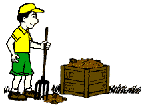 Since there are many ways of making compost, its actual composition will vary considerably. While the raw materials going into the compost pile are important, the value of the final compost depends upon the construction and management of the pile. There is a vast difference, for instance, between compost from a well-made, well-managed pile and that from the all-too-common untidy dump or hole in the ground. Also, a well-made pile is agreeable to work with while a random pile is generally messy and may breed flies and other problems. Following the general principles below will produce a neat and productive compost pile.
Since there are many ways of making compost, its actual composition will vary considerably. While the raw materials going into the compost pile are important, the value of the final compost depends upon the construction and management of the pile. There is a vast difference, for instance, between compost from a well-made, well-managed pile and that from the all-too-common untidy dump or hole in the ground. Also, a well-made pile is agreeable to work with while a random pile is generally messy and may breed flies and other problems. Following the general principles below will produce a neat and productive compost pile.
Always remember — NATURE MAKES THE COMPOST — you only furnish the area and do the work to help.
Site of the Pile
The composting site should be chosen with regard to these requirements: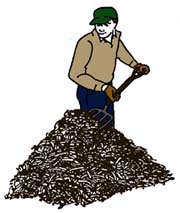
- Favorable conditions for the activities of the living organisms, fungi, bacteria, earthworms, etc.which carry out the processes of decomposition. Organisms need free contact with both soil and atmosphere and suitable environments of warmth and moisture. The pile should not be directly exposed to sun, wind, rain, nor sited in a low-lying place subject to unnecessary dampness and standing water. Strong sun not only dries, but also is hostile to micro-organisms. Wind cools and dries the pile, while excessive rain results in coldness, waterlogging, leaching of plant nutrients, and slowing of the composting process.
- Excess rain tends to sour compost, because anaerobic (airless) decay predominates instead of aerobic decomposition. Live vegetation, trees, shrubs and hedges provide good shelter when available. It should be kept in mind that what may be a good site in a warm, dry climate or in summer may be unsuitable under winter circumstances.
- Convenient location. Because of the labor in moving the materials to and from the pile, it should be located in a convenient location. If you are going to be making compost in bulk, it may be advisable to have piles in several places to save labor. On the other hand, speedy decomposition may be promoted by the interaction between piles grouped together. Such an arrangement is also conducive to good management. When several piles are sited together, sufficient space should be left either for making two heaps into one when turning, or for wheelbarrows or carts to get in and out of the area. The corner where little will grow is often a suitable compost site in a small garden.
Also, remember that you are going to want to turn the pile and will need room enough to do so.
After you have decided on the site of the pile, your next step is to consider building the pile. Ask yourself several important questions:
- Am I going to build the pile all at one time or build it up as materials become available?
- Will I use different materials or try to make it out of primarily just one material such as leaves?
- What will be used as a nitrogen source?
- How big will the compost pile be, and what type of structure is to be used?
- Do I want quick compost that requires more work or do I want a static pile?
- Am I willing to cut, chop, shred, and pulverize materials in order to have compost earlier?
Placement of Materials
Compost will occur in a pile of assorted organic debris that simply sits passively in the weather with no attention from human hands. However, a carefully constructed and tended pile will usually result in more satisfactory compost more quickly.
The bin, open pile, or windrow are by far the most widely used methods for the aerobic decomposition and maturing of organic refuse. The exact use and arrangement of these systems depend on available materials, labor, cost of systems, climatic conditions such as temperature, rainfall, and wind. The daily quantities of materials available for home gardeners will often be too small to permit the satisfactory use of windrows. In this case circular or rectangular piles approximately 3 feet in diameter and 3 to 5 feet high, with a rounded top for running off of the rain water, could be used.
If it is desired to maintain the composting process aerobically by frequent turning for aeration, windrows and piles and bins above the surface of the ground appear to be more efficient than pits. On the other hand, if the decomposition is to be entirely anaerobic, or aerobic only during a short initial period, pits 3 to 4 feet deep can be used.
Windrows, Piles and Bins
The material in aerobic composting piles should be loosely stacked to allow as much space for air between particles as possible. The windrows or piles may be of any convenient length, but the height of the pile is somewhat critical. If piled too high, the material will be compressed by its own weight, thus reducing pore space and resulting in increased turning labor or in an extended period of composting because anaerobic conditions develop.
Piles that are too low lose heat rapidly. Optimum temperatures for the destruction of pathogenic organisms and decomposition by thermophiles (high temperature microorganisms) are not obtained. Also, if the piles are too small, the loss of moisture may be excessive, especially near the edges, and decomposition will be retarded.
Experience will quickly demonstrate the most suitable height of the pile for any particular refuse. Four to five feet is about the maximum height for any refuse, and 3 1/2 feet is the minimum for most shredded home compost piles. The height can be greater in cold weather than in warm weather.
Constructing the compost pile, in bins, windrows or in piles, is usually described in terms of layers. In actual practice, such layers are less well defined. Layering helps to control the quantity and type of materials as well as the uniformity of the pile. Turning the pile incorporates materials for the quickest and most complete decomposition.
The pile may normally be started directly on the ground. However, to provide aeration to the bottom of the pile and improve drainage, dig a trench across the base of the area and cover with stiff wire mesh (hardware cloth) before the layers are begun, or stack small sticks or tree branches in a single layer to prevent the pile from resting directly on the ground. Aeration and drainage may also be improved by making a channel in the foundation in which is laid a core of brushwood, drain tiles or air-bricks placed in a “herring-bone” pattern.
Adding to the Pile
Non-fatty food scraps may be composted by incorporating them into the soil where they will break down to fertilize established or future plantings. Food scraps incorporated into the soil can take from one month to one year to fully decompose; and aerobic composting can compost a mixed load of food and yard trimmings in six weeks under optimum conditions. Below is an indicator of some of the food scraps that can and cannot be successfully home composted at home.
| Yes | No |
|---|---|
| apples | butter |
| apple peels | bones |
| cabbage | cheese |
| carrots | chicken |
| celery | fish scraps |
| coffee | grounds lard |
| egg shells | mayonnaise |
| grapefruit | meat scraps |
| lettuce | milk |
| onion peel | peanut butter |
| pears | salad dressing |
| pineapple | vegetable oil |
| potatoes | yogurt |
| pumpkin shell | |
| squash | |
| tea leaves | |
| tomatoes | |
| turnip leaves | |
| vegetable trimmings |
Handling Kitchen Scraps
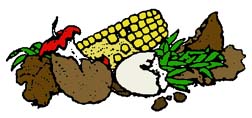 All composters will have their own methods for storing food scraps until they are ready to compost them. You can drain them in a colander as they are generated at each meal and place them into a container and take them out once a day to the compost pile. Place the scraps into a hole dug out of the pile and cover over with 4 to 6-inches of compost. It is best to use the “Clock Method” and dig a different hole around the pile clockwise each day. This will allow the material to begin breaking down without delay. The material needs to be incorporated because it may attract flies and gnats if it is left on the surface. A covering of leaves will also work if they are available.
All composters will have their own methods for storing food scraps until they are ready to compost them. You can drain them in a colander as they are generated at each meal and place them into a container and take them out once a day to the compost pile. Place the scraps into a hole dug out of the pile and cover over with 4 to 6-inches of compost. It is best to use the “Clock Method” and dig a different hole around the pile clockwise each day. This will allow the material to begin breaking down without delay. The material needs to be incorporated because it may attract flies and gnats if it is left on the surface. A covering of leaves will also work if they are available.
Moisture and Turning
All life on earth needs a certain amount of water and air to sustain itself. The compost pile is no different. The amounts of air and water in a compost pile is a delicate tradeoff which must be balanced for rapid decomposition to take place. At less than 40% moisture the bacteria are slowed by the lack of water. At greater than 60% moisture there is not enough air for aerobic decomposition, and anaerobic bacteria take over the pile.
A micro-organism farm, compost requires tending to its moisture needs just as the farmer tends to the irrigation of crops and ventilation of livestock enclosures. Fortunately, we have a simple rule of thumb: Compost should be about as moist as a wrung-out sponge. It should be obviously moist to touch, but yield no liquid when squeezed. This provides a thin film of moisture on materials for the decomposer organisms while still allowing air into their surroundings.
If the pile is too wet it should be turned (pulled apart and restacked). This will allow air back into the pile and loosen up the materials for better draining and air drying. A compost aeration tool is a good investment for the wet pile problem and for getting air into the pile in general. Simply jab it deeply into the pile and give it a small turn as you pull it out. The propeller at the end will fold out on the upstroke, loosening the materials and admitting more air.
If the pile is too dry you can try soaking it from above with a soaker hose. A more effective practice is to turn the pile and re-wet the materials in the process. Certain materials will shed water or absorb it only on their surface. Dead leaves, sawdust, hay, straw, and some dried weeds and vegetables must be gradually wetted until they glisten with moisture. Then they should be mixed until the water has been absorbed into their fibers.
Finished Compost

The compost will be finished when the pile cools off and decreases to about one-third of its original volume (depending on the original ingredients). It will be dark, crumbly, and have an earthy odor. The C:N ratio will be less than 15:1, approaching the value of humus in the soil, and the temperature will be within 10°F of the air temperature. Unfinished compost can be phytotoxic, especially to seedlings and newly established plants. Therefore, compost must be allowed to decompose thoroughlybefore using. While most compost will greatly improve soils for plants, unfinished compost, or compost resulting from anaerobic decomposition, can contain acids or alcohols that can harm or kill seedlings or sensitive plants.
How to build the compost pile
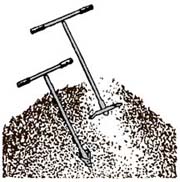
- You will need to collect enough material to create a 1-cubic-yard pile. The mixture should ideally approximate a 30:1 carbon-to-nitrogen ratio.
- Chop, cut, or shred any coarse materials to increase their surface area for microbes to work.
- Start the foundation of the pile by placing a 6-inch layer of bulky materials on the ground. Materials such as brush trimmings or wood chips can be used.
- Next add to the pile a 6-inch layer of high-carbon
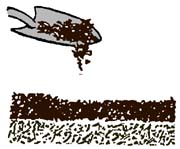 material (high C:N ratio) such as leaves, straw, hay or a mixture of these.
material (high C:N ratio) such as leaves, straw, hay or a mixture of these. - Water the pile – Conduct a squeeze test to gauge the moisture content of the compost materials. Add water until squeezing a handful will yield one or two drops of water. Adding too much water may leach out nutrients. Conduct this test each time you add composting materials and water.
- Consider the porosity of the mixture as you add it to the pile. If dense materials, such as manure or wet leaves, are used, wood chips, straw, or other dry, bulky material should be added to improve the porosity. The thickness of the layers will depend on the C:N ratio of the materials. Thicker layers (6-inch) of high C:N ratio or thinner layers (3-4 inches) of lower C:N materials should be used.
- Add a nitrogen source, such as ammonium nitrate, ammonium sulfate, an inexpensive high nitrogen lawn fertilizer without herbicide (NO WEED AND FEED FERTILIZERS) or a complete garden fertilizer such as 8-8-8 or 10-10-10. Add 1 cup of ammonium nitrate or 3 cups of 10-10-10 to each 3 bushels of leaves added to the pile. Less nitrogen will be needed if green nitrogen-containing trimmings or grass clippings are added. If fresh livestock or poultry manure is available, a 1 to 2-inch layer of manure can be used as your nitrogen source and substituted for the commercial fertilizer. Also, blood meal, cottonseed meal and other organic nitrogen sources can be used for nitrogen. You may choose to adda 1/4-inch layer of soil or completed compost over the nitrogen to increase the number of decomposing microbes in the pile. Much of the time leaves and plant scraps have enough micro-organisms to get the job done without the addition of soil or compost.
- As each layer is added, mix the layers together by interfacing them with the preceding one. This procedure will help to inoculate the pile and begin the composting process.
- Now add a 3 to 4-inch layer of high-nitrogen material (low C:N ratio). Vegetative kitchen scraps should be added in this layer. If very high-nitrogen materials are used, or materials that tend to mat such as grass clippings, kitchen scraps, etc., layers should be only 2 to 3-inches thick. If food wastes are added, an additional thin layer of soil, leaves, straw, or compost should also be added to absorb odors.
- Next, start again with the 6-inch layer of high C:N materials with the nitrogen sources sprinkled over them. These layers can be 4 to 6-inches deep. If you do not have the lower C:N ratio materials to put over the second layer of higher C:N materials, just add another layer of the higher C:N materials (leaves) and add a little more nitrogen (2/3 to 3/4 of a cup on nitrogen fertilizer per 3 bushels of material).
- Continue to alternate the layers of organic materials, fertilizers or manure, and soil until a maximum height of 3-5 feet is achieved. Firm each layer as it is added, but do not compact it so much that air can’t move freely through it. Water each layer as it is added. As organic materials decompose, their volume will decrease 20% to 60% depending on the character of the materials and the amount of compaction. The weight of finished compost is usually 50% to 80% of the original weight of the refuse. If the raw material contains a large quantity of organic matter, the weight loss will be much greater than when the mineral or ash content of the initial material is high.
The information given herein is for educational purposes only. Reference to commercial products or trade names is made with the understanding that no discrimination is intended and no endorsement by the Texas AgriLife Extension Service is implied.
Educational programs of the Texas AgriLife Extension Service are open to all people without regard to race, color, sex, disability, religion, age, or national origin.
Publication Revised February 2009

